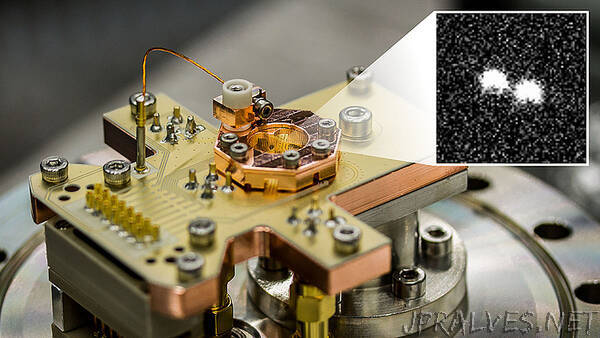
“New approach for controlling qubits via microwave pulses reduces error rates and increases efficiency
A functional quantum computer is one of the most intriguing promises of quantum technology. With significantly increased computing power, quantum computers will be able to solve tasks that conventional computers cannot handle, such as understanding and inventing new materials or pharmaceuticals as well as testing the limits of cryptographic techniques.
Like in conventional computers, the term quantum bit or qubit refers to the basic unit in quantum information. Presently, the most advanced approaches for realising them are superconducting circuits and trapped ions. The former stores quantum information in electronic components, the latter in different energy levels of single atoms. By using superconducting circuits, researchers recently succeeded in demonstrating that quantum computers are able to perform highly specialised tasks that conventional computers cannot handle. However, in contrast to any other approach, ions produce significantly lower error rates in operations.
In order to reduce error rates even further and provide reliable operations much faster, researchers at Leibniz University Hannover and Physikalisch-Technische Bundesanstalt (PTB) have now developed a new method. Their findings have been published in the latest issue of the scientific journal “Physical Review Letters”.
In their approach, ions are trapped under vacuum by using electric fields above a chip structure. Qubit operations are implemented by sending microwave signals through special conductor loops embedded in the chip structure. Usually, logic operations are carried out via extremely carefully controlled laser beams. Using microwave fields has the advantage that they are both relatively easy to control and a highly mature technology since they are omnipresent in numerous products from planes to mobile phones.
Within the scope of the study, researchers investigated the most efficient methods for operations on qubits. This is also a highly relevant issue in conventional computer chips, as the amount of energy necessary per operation determines how many of them can be processed per second before the chip starts to overheat. Regarding ion-trap microwave quantum computers, the researchers succeeded in demonstrating that specifically shaped microwave pulses, where the field is turned on and off smoothly, produce error rates 100 times lower than those where the fields are simply switched on and off - with the same energy input and despite the presence of noise. For this purpose, the team introduced additional and carefully controlled noise into the experiment and determined operation errors for varying levels of injected noise as well as for both pulse shapes. “This made a huge difference for our experiment”, said Giorgio Zarantonello, one of the authors of the study. “In the past, finding suitable operations involved much trial and error as well as a long optimisation process before catching a moment with very little noise. All we have to do now is to switch on the experiment and it works”.
After demonstrating that basic operations with low error rates are feasible, the researchers now aim to transfer their findings to tasks that are more complex. The intention is to achieve less than one error in every ten thousand operations, which is when scaling to a large number of qubits becomes efficient. For this task, they have already developed a patented microfabrication technology that supports the storage and manipulation of a large number of qubits in a chip structures.
The project was funded by the German Research Foundation (DFG) through the collaborative research centre 1227 “DQ-mat”, which focuses on controlling complex quantum mechanical systems. The collaborative research centre consists of researchers in the fields of experimental and theoretical physics from Leibniz University Hannover, the Centre of Applied Space Technology and Microgravity (ZARM) in Bremen, and PTB Braunschweig. Furthermore, the study was funded by the EU quantum technology flagship. In order to translate fundamental research findings in quantum physics into technology, the EU and its member states plan to invest one billion euros over the next ten years. The “MicroQC” project brings together researchers from Hannover, Braunschweig, Siegen, Sussex, Jerusalem, and Sofia.
Original article
G. Zarantonello, H. Hahn, J. Morgner, M. Schulte, A. Bautista-Salvador, R.F. Werner, K. Hammerer, C. Ospelkaus,
Robust and Resource-Efficient Microwave Near-Field Entangling 9Be+ Gate Phys. Rev. Lett. 123, 260503 (2019).
https://doi.org/10.1103/PhysRevLett.123.260503”
